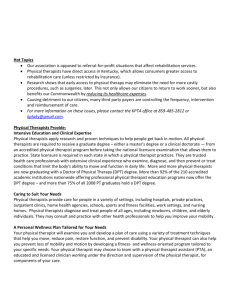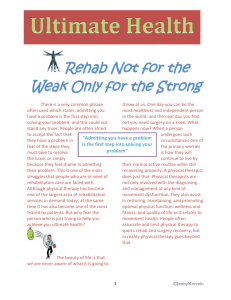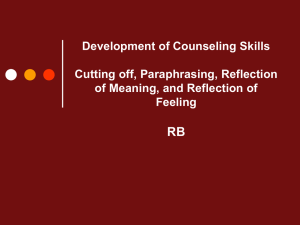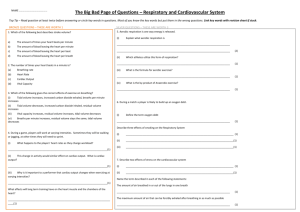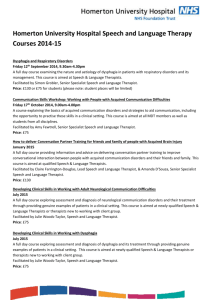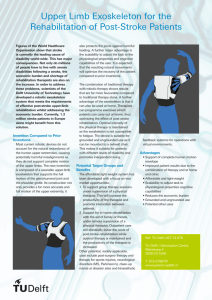Liz Kleckner PT100 Library Project 11/26/12 Post Heart Attack
advertisement
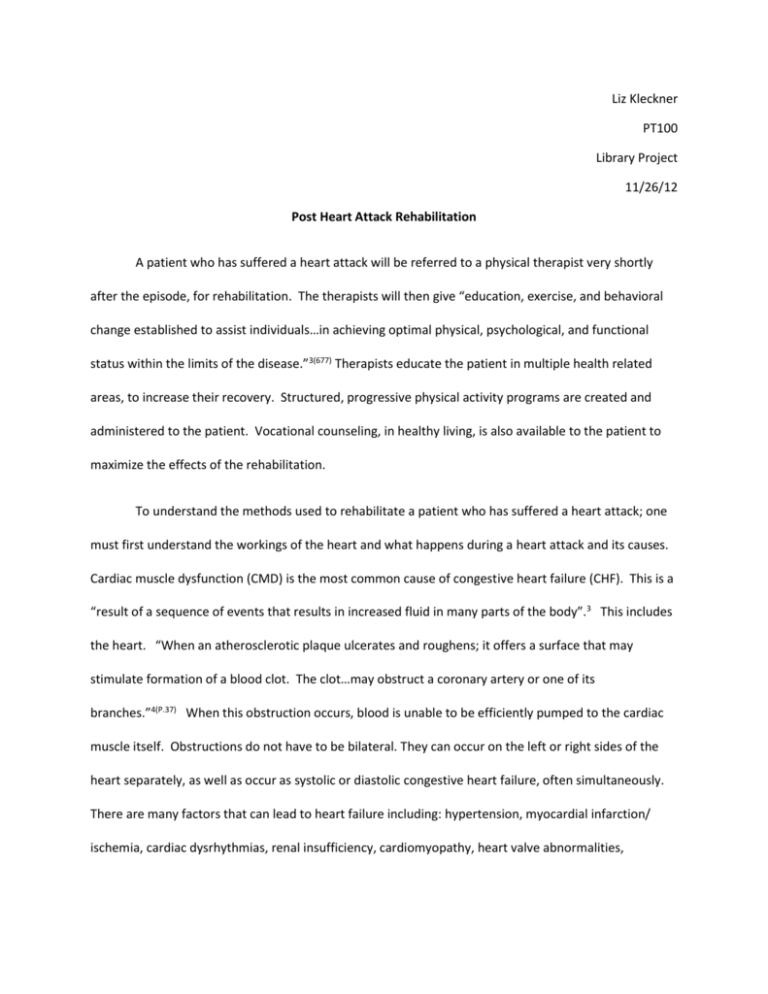
Liz Kleckner PT100 Library Project 11/26/12 Post Heart Attack Rehabilitation A patient who has suffered a heart attack will be referred to a physical therapist very shortly after the episode, for rehabilitation. The therapists will then give “education, exercise, and behavioral change established to assist individuals…in achieving optimal physical, psychological, and functional status within the limits of the disease.”3(677) Therapists educate the patient in multiple health related areas, to increase their recovery. Structured, progressive physical activity programs are created and administered to the patient. Vocational counseling, in healthy living, is also available to the patient to maximize the effects of the rehabilitation. To understand the methods used to rehabilitate a patient who has suffered a heart attack; one must first understand the workings of the heart and what happens during a heart attack and its causes. Cardiac muscle dysfunction (CMD) is the most common cause of congestive heart failure (CHF). This is a “result of a sequence of events that results in increased fluid in many parts of the body”.3 This includes the heart. “When an atherosclerotic plaque ulcerates and roughens; it offers a surface that may stimulate formation of a blood clot. The clot…may obstruct a coronary artery or one of its branches.”4(P.37) When this obstruction occurs, blood is unable to be efficiently pumped to the cardiac muscle itself. Obstructions do not have to be bilateral. They can occur on the left or right sides of the heart separately, as well as occur as systolic or diastolic congestive heart failure, often simultaneously. There are many factors that can lead to heart failure including: hypertension, myocardial infarction/ ischemia, cardiac dysrhythmias, renal insufficiency, cardiomyopathy, heart valve abnormalities, pericardial effusion or myocarditis, pulmonary embolism or pulmonary hypertension, spinal cord injury, and age related changes.3 While cardiovascular medications, like beta blockers and alpha adrenergic blockers, are an initial treatment to a heart attack, the episode is almost immediately followed up with physical therapy.3 To get a starting point for the patient, an initial assessment is done before a program is started.3(682) This assessment is often performed with a stress test. The patient’s vitals are recorded in a resting state as well as while performing light activity, to get baseline readings for the individual.2(384) After these initial tests, an individualized exercise program is created for the patient. Individual programs are designed to be progressive and become more challenging as the patient becomes stronger.3(682) These programs generally follow a structure of stretching activities, a light aerobic warm up, weight training, and more intense cardio exercises, followed by a cool down. During the entire duration of the exercise, the therapist must monitor the patient for any abnormal reactions as well as periodically checking vital signs throughout the therapy. The patient describes the difficulty of the activity using a numbered exertion scale.6 The numbers are recorded and used to determine when the difficulty of an activity should be increased. Eventually there should be an improvement in aerobic capacity and cardiac output of the patient. Recently telerehab has been used, in some cases, so that the patient can perform exercises at home but has access to therapists via the phone.5 This is helpful for people who have limited means of transportation. There have been many studies that show that exercise is the best method for recovery after a heart attack. “Regular exercise has obtained class of recommendation 1, level of evidence A.”5 Many people who have had a heart attack, reduce their activity level greatly, becoming inactive, this reduces overall fitness, making symptoms worse.1 One study states, “The specific demand of habitual physical exercise produces a biochemical change that ultimately enhances the functioning of skeletal muscle and cardiovascular system.”3(692) This increased functioning is essential to the recovery of a patient who has suffered a heart attack. Another study declares, “Heart rate, systolic blood pressure, and the rate of pressure product are generally lower during submaximal efforts following exercise conditioning, resulting in reduced myocardial oxygen demand.”3(681) Regular exercise will help to keep all of these factors lowered and at a healthy level. There are several areas of rehabilitation that are included, outside of the initial exercise plan. Weight loss may be suggested to have a healthier, more effective recovery. To assist with this therapist may suggest certain other exercises that can be done at home or in addition to the original exercise plan. Diet tips or referral to a nutritionist may also be included by the therapist. Therapist will also strongly encourage any patients using tobacco products to quit, increasing the effectiveness of the recovery. One of the largest areas that will be discussed by a therapist, aside from the exercise plan, is dealing with stress. Therapists teach patients to identify stressors then defuse the negative emotions that follow. Using humor, physical activity, and mediation are commonly taught stress releasers.6 Prevention of future episodes is a major focus in therapy post heart attack. The patient is expected to make life changes that continue after they are discharged from therapy. This includes incorporating regular exercise in their daily lives. Evidence shows that aerobic exercise reduces the chance of hospital admissions due to heart failure.1 Patients who continue to live actively after discharge are less likely to relapse with more heart problems.6 Works Cited 1. Davies E, Moxham T, Rees K, et al. Exercise based rehabilitation for heart failure. Library. http://onlinelibrary.wiley.com. Published 14 April 2010. Accessed 10 November 2012. 2. Frownfelter D. Cardiovascular and Pulmonary Physical Therapy: Evidence and Practice. St. Louis: Mosby/ Elsevier; 2006. 3. Hillgrass A. Essentials of Cardiopulmonary Physical Therapy. St. Lewis: Saunders; 2001. 4. Macauley K. Physical therapy management of two patients with stage D heart failure in the cardiac medical intensive care unit. Cardiopulmonary Physical Therapy Journal. 2012; 23(3):37-45. 5. Piotrowicz E. How to do telerehabilitation in heart failure patients. Cardiology Journal. 2012; 19 (3): 243. 6. Scot I. Cardiopulmonary Physical Therapy. Bolinas: Mosby; 1995.

